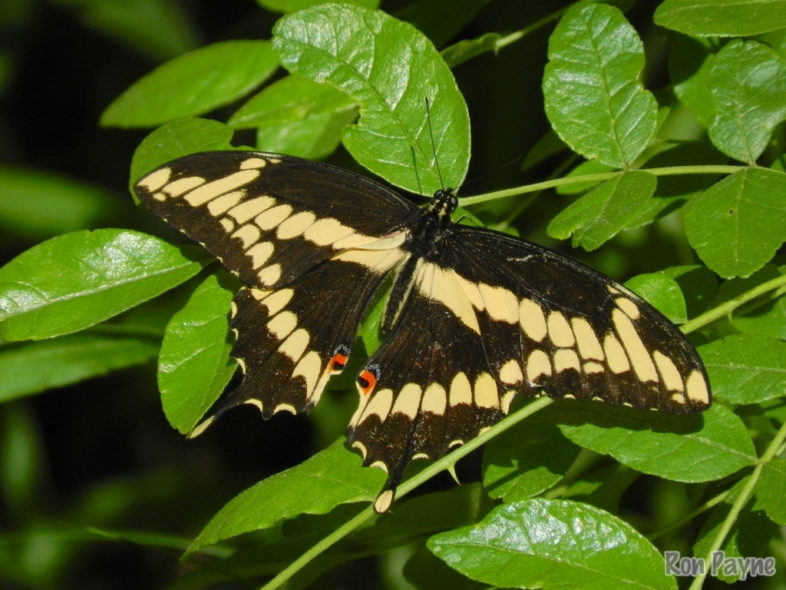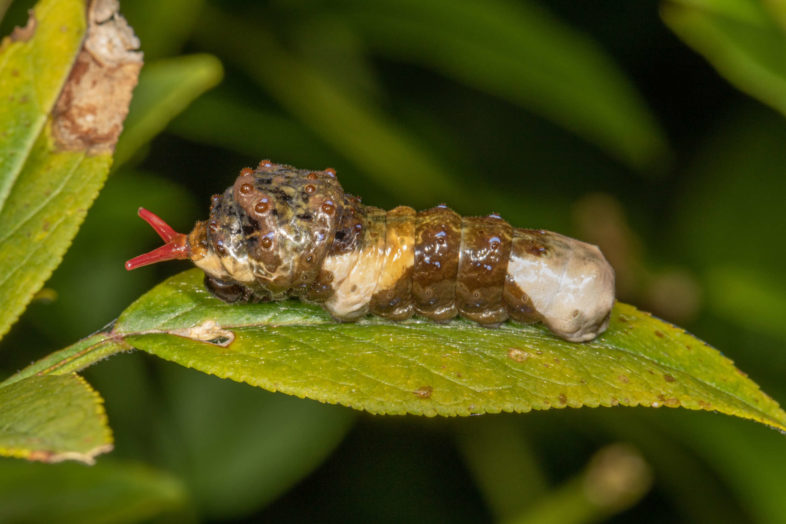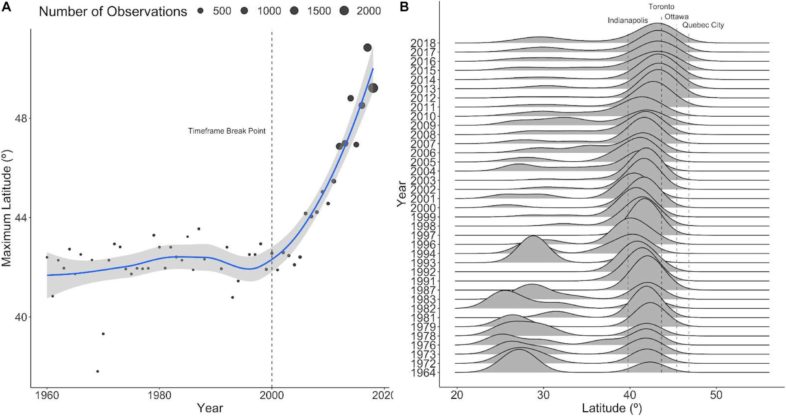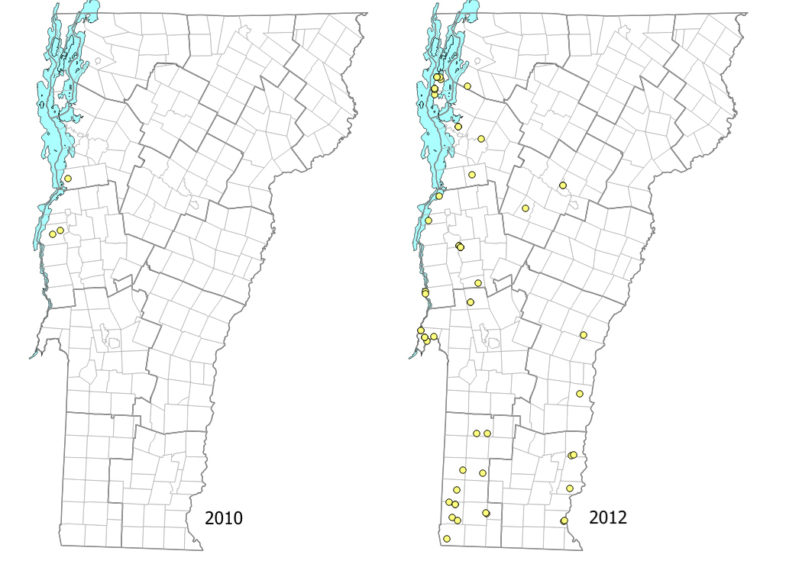
Eastern Giant Swallowtail on its native host plant in Vermont, Northern Prickly-ash (Zanthoxylum americanum). Click the image to visit this observation at the Vermont Atlas of Life on iNaturalist. © Ron Payne
It’s hard to miss a giant. In 2010 when the largest butterfly in North America fluttered among Ardys Fisher’s flowers at the end of July, she knew it was something neat. Her husband Lionel snapped some photos and with a little help from the internet and confirmation from VCE, this became the first record of an Eastern Giant Swallowtail in Vermont.
The Vermont Butterfly Survey examined thousands of specimens in museums and published records of butterflies from Vermont to confirm that this was the first sighting recorded in the state. But despite the lack of evidence of previous sightings, it might have visited Vermont about 100 years ago. Samuel Scudder described a prolonged northward invasion of giant swallowtails from the 1870s into the early 1900s, reaching upstate New York and as far north as Montreal. But by the 1930s they apparently faded southward again and were considered to be just a rare vagrant in Massachusetts once again.
From 1991-2008 only two sightings were reported in Massachusetts. Farther south, the Connecticut Butterfly Atlas found none during surveys conducted from 1995-1999 and the 2007 Rhode Island checklist labeled the species “historical.” None were found during the Vermont Butterfly Survey from 2002-2007.
But the Fisher’s 2010 sighting was a bellwether for things to come. In 2011 there was a massive explosion of Eastern Giant Swallowtails throughout the Northeast. Beginning in August and ending with the first frost, sightings were reported from across Vermont and beyond. Incredibly, some were even finding caterpillars.
Eastern Giant Swallowtail caterpillars can feed on just a few plants, mostly in the citrus family (Rutaceae). Farmers in the south call the caterpillars “orange dogs” because of the devastation they can cause in their citrus orchards. But one host plant that grows in some parts of Vermont is Northern Prickly-ash (Zanthoxylum americanum), a shrub that grows in old fields, fencerows, riverbanks, and forest edges, sometimes forming thickets. The traveling swallowtails quickly colonized these new patches.

Eastern Giant Swallowtail caterpillar on Gas Plant in a Vermont garden. The camera lens apparently threatened it and so it is extending its osmeterium in warning. © Kent McFarland
The caterpillars rely on camouflage, chemistry, and mimicry for protection. Their resemblance to bird droppings hides them and may even deter predators. And when disturbed, mature larvae rapidly extend bright orange and fleshy “horns” hidden within the thoracic segment behind their head called osmeterium. This gland is thought to scare potential predators because it mimics a snake’s tongue. And if that’s not frightening enough, then perhaps the release of noxious defensive chemicals might also help to deter the predator.
With observers finding caterpillars, the butterflies were clearly reproducing–but could they make it through a northern New England winter? If caterpillars could avoid early frost and the chrysalises in which they overwinter were greeted with mild weather, it might be possible. Our network of naturalists was alerted and would be on the lookout in the spring.
In early May we got the answer. Keen naturalists like Sue Elliott reported fresh adults in West Haven and Terri Armata found them in Bennington. Soon, observations began to pour in from many areas west of the Green Mountains. The spring flight was successful and the second one in late summer and fall was even bigger. Once again Eastern Giant Swallowtails were seen fluttering across many areas of Vermont and once again, many reported caterpillars on prickly-ash as well as Gas Plant (Dictamnus albus), a common garden bush also used as a host. One person even reported them feeding on a lone potted citrus plant placed outside on a deck for the summer.
Now, over a decade later, the Eastern Giant Swallowtail is a regular resident butterfly in parts of Vermont and beyond—successfully breeding as far north as Montreal.
Thanks to the efforts of thousands of butterfly watchers reporting their sightings to projects such as iNaturalist.org and eButterfly.org, coupled with the massive biodiversity data being shared at the Global Biodiversity Information Facility (GBIF), we were able to study in detail the rapid flight northward by Eastern Giant Swallowtails.
A recent study published in Frontiers in Ecology and Evolution by VCE and colleagues in the U.S., Canada, and France shows an unusually rapid northward range shift by the butterfly. Over the course of 18 years, the range of the Eastern Giant Swallowtail moved just over 200 miles north—a rate of expansion more than 27 times faster than the average organism.
“Butterflies are pretty mobile. The swallowtails we worked on are more on the mobile side of things,” said Keaton Wilson, who completed his postdoctoral research at the University of Arizona and is the lead author. “The tricky thing is they can move north, but they’re really restricted by their host plants.”
Our study brings together a combination of museum collection, survey, and community science data to understand how host plant availability, climate changes, and butterfly abundance are influencing the rapid expansion of a herbivorous insect as a case study. This study is one of few to demonstrate the interplay of both climate change and biotic interactions in shaping range limits while focusing on the ecologically important role of herbivores.
We amassed over 8,000 Eastern Giant Swallowtail occurrence records, nearly 2,700 host plant records, and TerraClimate data (monthly climate and climatic water balance data) from 1958-2019 for each ~4 kilometer area across the globe. Using these data with a powerful machine learning algorithm called MaxEnt, we modeled the ranges of the butterfly and its three native host plants during two time periods–prior to the beginning of the explosion northward (1959-1999) and the period when it began (2000-2018).
Our study found that recent climatic shifts, particularly warmer and wetter climate during the breeding season and warmer temperatures during the pupal overwintering season, have allowed the Eastern Giant Swallowtail to rapidly expand its range northward to now match or even surpass the slower moving northward range expansion of its northernmost host plant, Northern Prickly-ash. The range expansion of the swallowtail further northward is now limited by the host plant range, not climate.

Evidence of northward range shift of P. cresphontes from raw occurrence data. (A) The maximum latitude of a recorded occurrence of P. cresphontes by year. Larger circles indicate years with higher numbers of occurrence records (high numbers in more recent years are due to increased citizen-science activity). The dashed lines represent the breakpoint between T1 and T2. Three years with extremely low maximum latitudes (<35) were omitted for clarity. The blue line and gray bar represent the loess smoothing curve and 95% confidence interval. (B) A ridge-plot of kernel density estimates of occurrences for P. cresphontes. Vertical dashed lines represent latitudes of major cities within the range. Years with <5 occurrence records were removed from plotting.
Though sightings of adult giant swallowtails will likely continue to be seen further north than the naturally occurring host plant range, without a suitable host plant, further northward expansion is unlikely, but can occur in horticultural settings. Eastern Giant Swallowtail adults lay eggs and caterpillars feed on non-native plantings of Garden Rue (Ruta graveolens) and Gas Plant. Common Hoptree (Ptelea trifoliata), is increasingly planted as an ornamental in the Northeast yet is a native species from central and southeastern North America. Although these exotic plants are not distributed uniformly across the region, dispersing giant swallowtails have an uncanny ability to find even the smallest plantings, perhaps further enabling them to expand their range in urban and suburban areas as climatic conditions allow.
What other insect ranges are moving northward or upward in elevation? How are invasive insects spreading across the region? There is so much basic insect biogeography that we don’t know. There is a rapidly growing urgency to quantify and monitor changes in insect ranges from climate change and habitat loss for us to better manage and preserve the integrity of ecosystem function. This can only be fully accomplished using the power of community science recording our changing world across the landscape. Join a Vermont Atlas of Life project and help us discover biodiversity.
Source publication: Wilson J. Keaton, Casajus Nicolas, Hutchinson Rebecca A., McFarland Kent P., Kerr Jeremy T., Berteaux Dominique, Larrivée Maxim, Prudic Kathleen L. (2021). Climate Change and Local Host Availability Drive the Northern Range Boundary in the Rapid Expansion of a Specialist Insect Herbivore, Papilio cresphontes. Frontiers in Ecology and Evolution 9:85. https://doi.org/10.3389/fevo.2021.579230


Great article
Great job Ken! Miss ya buddy your old friend fish!
If you read the whole thing and you made it to the comments, thanks! A few have asked when I saw my first one in Vermont. It was I think 2012 and I was actually on a fire call! I was driving the engine and the crew was just wrapping up a minor situation with an overheated cooling unit on a rooftop. I was standing beside the engine with the assistant chief at the time and way down the parking lot I saw this thing as big as a bat flapping chest high towards us. I was so excited I yelled out – giant swallowtail! The chief got on it too, mind you he wasn’t a butterfly watcher, poor soul, but he couldn’t help but admire this beast as iit fluttered past us in all its giant glory. Perhaps the best species i have seen while on scene! LOL!
Funny story. I would love to get a photo of one.
sadly the western giant swallowtail doesn’t get anywhere near PNW.
exciting to see one today in the adk town of westport ny!
with a wingspan as big as the palm of my hand and narrow bright yellow dashes on a blackish body,
shaped like a huge smile.
maybe it was the orange peels i threw in my garden that drew her?😉
Neat! If you can add your observation to e-Butterfly.org or inaturalist.org, we’d love to have these collected.
Eek. Is gas plant the same as burning bush?
Definitely not. Burning Bush (aka Winged Euonymus) is of course a problematic invasive species in some woodlands (one above my house for example!) and it has the latin name Euonymus alatus. Here’s a link to records for that in Vermont on our iNaturalist project: https://www.inaturalist.org/observations?captive=any&place_id=any&project_id=558&taxon_id=117433&verifiable=any. You can see it is reported all over. Gas Plant has the latin name Dictamnus albus. And it is also called dittany, fraxinella, Dictamnus, and (unfortunately) Burning Bush. Just to confuse all of us! Apparently it gets this name, and perhaps Gas Plant too, because it produced volatile chemicals that in hot weather can combust rather easily. It is likely these chemicals, that the giant swallowtail caterpillar seeks perhaps.
Thank you! One of the joys of common names for plants🤣…but one that I will cling to as scientific names are overwhelming to me.😱
Hi Kent;
We live in Granville, Vermont. Last July 2020, we had one Giant Swallowtail floating around our front gardens.
Two summers ago, we saw one also here and then one in Rochester Vermont. Always surprising to see. Thank you for your really interesting article. Lots of Monarchs last summer; fewer and fewer other butterflies and meadow insects… Best- Clare Walker Leslie
Glad to find this article! Just saw one in my garden today 8/15/22, and new it was something special. I’m 20 miles north of Saranac Lake, NY. It is huge and loving my perennial garden.
This year I was able to see some of the caterpillar of the Giant Swallowtail Butterfly. I live in Tampa FL and it was the first time seen them. There were a few however do to much rain there is only one…Hopefully that one will become a butterfly…..
I would like to know the difference between a male and female swallowtail. I raised seven monarch chrysalis. The one that emerged lived 9 weeks in captivity! It was too cold to let him go. I saw a swallow tail just earlier—I think it was a male, had bright yellow markings!—and I would love if you made a article or added on to this one, about the difference. Thank you for the work you do!
Do you mean for Eastern Giant Swallowtail or for another species? Here’s a link that will help you with that species – https://bugguide.net/node/view/8920#:~:text=One%20can%20see%20the%20black,it%20is%20tough%20to%20tell.
Thank you for replying! I appreciate the information, and it is a Giant Eastern Swallow! Thanks for the link!